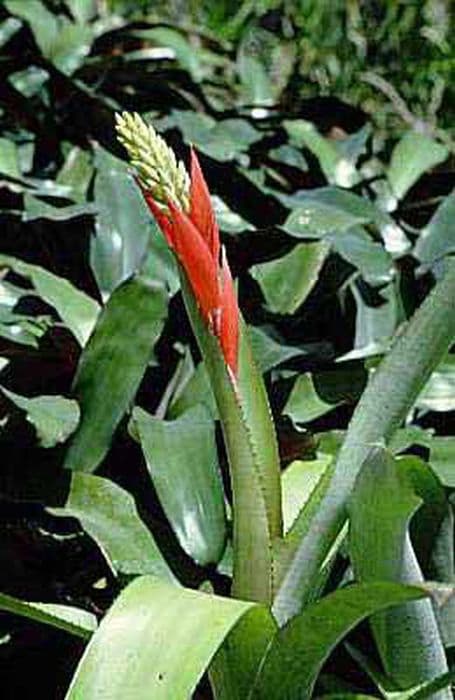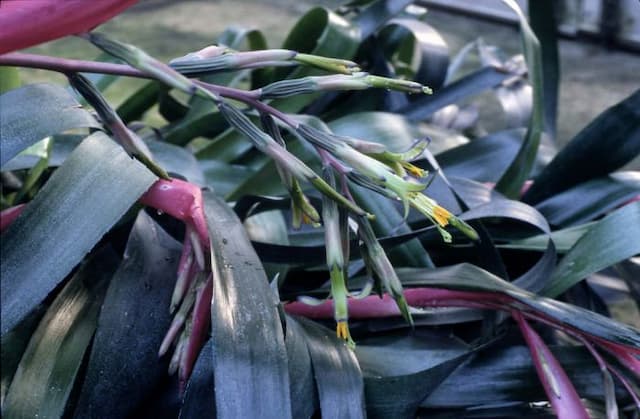Friendship Plant Billbergia nutans

ABOUT
The Queen’s Tears plant is an eye-catching and elegant species that exhibits a blend of both foliage and floral beauty. The leaves are strap-like, long, and arching, forming a tight, vase-like rosette. These leaves boast a rich green color with silver banding underneath, giving them a two-toned effect that adds to the visual interest of the plant. The truly distinctive features, however, are the colorful inflorescences it produces. These blossoms dangle from the rosette like a pendant, with bracts that can be colored in shades of pink, red, or green. Hanging amidst the bracts are the actual flowers, which showcase an exquisite array of colors including green, blue, and purple, often accented with delicate yellow or red edges. The petals are thin and recurved, adding a delicate and exotic touch to the already striking flower. The combination of the hanging blooms and the attractive foliage make Queen’s Tears a favorite among plant enthusiasts who seek to add a tropical flair to their surroundings. Despite its royal name and exotic appearance, the plant is known to be quite hardy and forgiving, often thriving with minimal care. Its allure is enhanced by the occasional appearance of small offsets, or "pups," that emerge around the base of the mother plant, hinting at its capability to multiply and grace its environment with even more of its unique beauty.
About this plant
 Names
NamesFamily
Bromeliaceae
Synonyms
Queen's Tears, Friendship Plant, Hanging Rope, Slim Lady, Angel's Tears
Common names
Billbergia linearifolia, Billbergia minuta, Billbergia schimperiana.
 Toxicity
ToxicityTo humans
The plant commonly known as the Friendship Plant (Billbergia nutans) is generally considered non-toxic to humans. No significant toxicity has been reported from ingesting parts of this plant. Thus, if ingested, it is unlikely to cause poisoning or serious consequences to human health.
To pets
The Friendship Plant (Billbergia nutans) is also non-toxic to pets such as dogs and cats. It does not contain any known harmful substances that would lead to poisoning if pets consume parts of the plant. Therefore, ingesting this plant should not cause any significant adverse health effects in pets.
 Characteristics
CharacteristicsLife cycle
Perennials
Foliage type
Evergreen
Color of leaves
Green
Flower color
Mixed
Height
1-2 feet (30-60 cm)
Spread
1-2 feet (30-60 cm)
Plant type
Herb
Hardiness zones
9
Native area
South America
Benefits
 General Benefits
General Benefits- Easy Care: Queen's Tears are known for being low-maintenance, requiring minimal watering and care, making them suitable for novice gardeners.
- Drought-Tolerant: It can withstand periods of dryness, thus conserving water and suiting xeriscaping principles.
- Unique Aesthetic: Queen's Tears boast attractive, arching foliage and distinctive, colorful flowers that enhance visual interest in gardens and homes.
- Non-Toxic: The plant is safe to grow around pets and children as it is not known to be toxic.
- Adaptability: It can thrive in a variety of environments, both indoors and outdoors, in a range of light conditions.
- Ornamental Container Plant: Ideal for container gardening due to its compact size and striking appearance.
 Medical Properties
Medical PropertiesThis plant is not used for medical purposes.
 Air-purifying Qualities
Air-purifying QualitiesThis plant is not specifically known for air purifying qualities.
 Other Uses
Other Uses- Queen's Tears as a living ornament can be hung in glass globes or terrariums, providing an aesthetic, low-maintenance decoration for indoor spaces.
- The plant serves as an educational tool in botanical studies to demonstrate bromeliad growth patterns, including their unique water-holding structures and pup production.
- Queen's Tears can be used as a natural humidifier, as its transpiration process adds moisture to the air around it.
- Its colorful bracts and flowers make Queen's Tears a natural choice for adding a splash of color in subdued gardens or landscapes.
- Due to its easy propagation through pups, Queen's Tears can be shared amongst gardening enthusiasts as a symbol of friendship and community.
- With its durability and low water needs, Queen's Tears works well as a teaching plant for children to learn basic gardening and responsibility.
- The versatility of Queen's Tears makes it suitable as a living gift that can be appreciated for its beauty and ease of care.
- In floral arrangements, Queen's Tears can provide an exotic and long-lasting element due to its sturdy flowers and bracts.
- For eco-friendly gardening practices, Queen's Tears can be a part of xeriscaping, which reduces the need for supplemental water from irrigation.
- When planted outdoors, Queen's Tears can attract pollinators such as hummingbirds, offering an ecological benefit to the garden ecosystem.
Interesting Facts
 Feng Shui
Feng ShuiThe Friendship Plant is not used in Feng Shui practice.
 Zodiac Sign Compitability
Zodiac Sign CompitabilityThe Friendship Plant is not used in astrology practice.
 Plant Symbolism
Plant Symbolism- Friendship: Also known as the Queen's Tears or Friendship Plant, Billbergia nutans symbolizes bonds between friends, likely due to its easy propagation and sharing nature amongst plant enthusiasts.
- Resilience: The plant’s ability to withstand various conditions and still thrive is often seen as a representation of resilience and survival.
- Gratitude: The Billbergia nutans is sometimes given as a gift to express gratitude, perhaps for the tear-like droplets it can emit, resembling a gesture of emotional appreciation.
 Water
WaterThe Queen's Tears should be watered regularly, ensuring the soil remains moist but not waterlogged. Ideally, water the plant every 7 to 10 days, pouring about 8 to 16 ounces of water directly into the soil, depending on the pot size and indoor conditions. It’s important to also fill the central cup of the plant with water, which can be emptied and refreshed every month to prevent stagnant water and possible rot. Reduce watering in the winter months when the plant is not actively growing.
 Light
LightQueen's Tears thrive in bright, indirect sunlight, making an east- or west-facing window a suitable spot for the plant. Direct sunlight should be avoided as it can scorch the leaves, while too little light may impede flowering. Providing filtered sunlight will help ensure vibrant growth and promote the plant's distinctive blooms.
 Temperature
TemperatureQueen's Tears prefer temperatures between 60°F and 80°F, which are typical of indoor environments. They can survive minimal dips to about 40°F but should be protected from frost. Ideal growing conditions include warm days and cooler nights, mimicking their native habitat.
 Pruning
PruningPruning Queen's Tears is necessary to remove spent flower stalks and to maintain the plant's size and shape. Prune after the plant has finished flowering, typically in late spring or early summer. Dead or damaged leaves can also be removed at this time to encourage new growth and improve air circulation.
 Cleaning
CleaningAs needed
 Soil
SoilThe best soil mix for the Queen's Tears (Billbergia nutans) is a well-draining, orchid potting mix with added perlite or coarse sand to ensure good aeration. The ideal soil pH should range between 5.5 to 6.0 to maintain healthy growth.
 Repotting
RepottingQueen's Tears (Billbergia nutans) should be repotted every two to three years, or when it outgrows its pot, to ensure ample space for root development and to refresh the potting medium.
 Humidity & Misting
Humidity & MistingQueen's Tears (Billbergia nutans) thrives in high humidity conditions, ideally between 50% and 70%, to mimic its natural tropical habitat.
 Suitable locations
Suitable locationsIndoor
Place Queen's Tears (Billbergia nutans) in bright, indirect light indoors.
Outdoor
Grow Queen's Tears (Billbergia nutans) in dappled shade outside.
Hardiness zone
9-11 USDA
 Life cycle
Life cycleBillbergia nutans, commonly known as the Friendship Plant, begins its life cycle when a seed germinates, typically in a warm and moist environment. The seedling develops into a rosette of strap-shaped green leaves, which can take several months to a few years to mature. During maturity, the plant produces a hanging inflorescence consisting of pink bracts and blue-violet flowers, which is usually triggered by shorter daylight hours and cooler temperatures. After flowering, which may last several weeks, the plant sets seeds while the original rosette slowly starts to decline. Simultaneously, the Friendship Plant produces offsets, or "pups," at the base of the mother plant, which can be separated and replanted to start new plants. Once the original plant completes its blooming cycle, it eventually dies, leaving the pups to continue the growth cycle.
 Propogation
PropogationPropogation time
Spring-Early Summer
Billbergia nutans, commonly known as Queen's Tears or Friendship Plant, is often propagated through the division of offsets, which is the most popular method. These offsets, also known as pups, emerge from the base of the mother plant. The best time to propagate is in spring or early summer when the plant is actively growing. Once the pups are about one-third to one-half the size of the parent and have several roots, they can be gently removed with a sterilized knife or scissors. The pups should be planted in a well-draining soil mix, with the base of the pup just below the soil surface. After planting, water sparingly until new growth indicates that the pup has established roots, which typically takes a few weeks. This method allows for a fairly quick and successful propagation, yielding new plants that will reach maturity and bloom within a couple of growing seasons.









